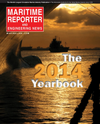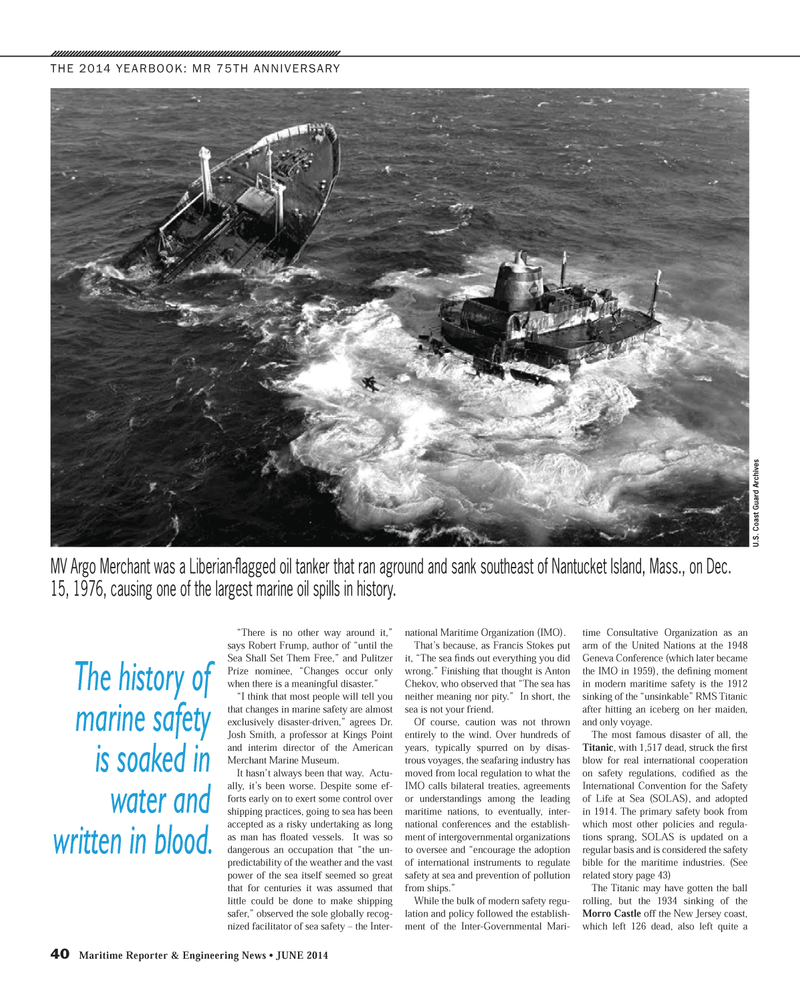
Page 40: of Maritime Reporter Magazine (June 2014)
Annual World Yearbook
Read this page in Pdf, Flash or Html5 edition of June 2014 Maritime Reporter Magazine
40 Maritime Reporter & Engineering News • JUNE 2014
U.S. Coast Guar d Ar chives
MV Argo Merchant was a Liberian-fl agged oil tanker that ran aground and sank southeast of Nantucket Island, Mass., on Dec. 15, 1976, causing one of the largest marine oil spills in history. “There is no other way around it,” says Robert Frump, author of “until the
Sea Shall Set Them Free,” and Pulitzer
Prize nominee, “Changes occur only when there is a meaningful disaster.” “I think that most people will tell you that changes in marine safety are almost exclusively disaster-driven,” agrees Dr.
Josh Smith, a professor at Kings Point and interim director of the American
Merchant Marine Museum.
It hasn’t always been that way. Actu- ally, it’s been worse. Despite some ef- forts early on to exert some control over shipping practices, going to sea has been accepted as a risky undertaking as long as man has ? oated vessels. It was so dangerous an occupation that “the un- predictability of the weather and the vast power of the sea itself seemed so great that for centuries it was assumed that little could be done to make shipping safer,” observed the sole globally recog- nized facilitator of sea safety – the Inter- national Maritime Organization (IMO).
That’s because, as Francis Stokes put it, “The sea ? nds out everything you did wrong.” Finishing that thought is Anton
Chekov, who observed that “The sea has neither meaning nor pity.” In short, the sea is not your friend.
Of course, caution was not thrown entirely to the wind. Over hundreds of years, typically spurred on by disas- trous voyages, the seafaring industry has moved from local regulation to what the
IMO calls bilateral treaties, agreements or understandings among the leading maritime nations, to eventually, inter- national conferences and the establish- ment of intergovernmental organizations to oversee and “encourage the adoption of international instruments to regulate safety at sea and prevention of pollution from ships.”
While the bulk of modern safety regu- lation and policy followed the establish- ment of the Inter-Governmental Mari- time Consultative Organization as an arm of the United Nations at the 1948
Geneva Conference (which later became the IMO in 1959), the de? ning moment in modern maritime safety is the 1912 sinking of the “unsinkable” RMS Titanic after hitting an iceberg on her maiden, and only voyage.
The most famous disaster of all, the
Titanic, with 1,517 dead, struck the ? rst blow for real international cooperation on safety regulations, codi? ed as the
International Convention for the Safety of Life at Sea (SOLAS), and adopted in 1914. The primary safety book from which most other policies and regula- tions sprang, SOLAS is updated on a regular basis and is considered the safety bible for the maritime industries. (See related story page 43)
The Titanic may have gotten the ball rolling, but the 1934 sinking of the
Morro Castle off the New Jersey coast, which left 126 dead, also left quite a
The history of marine safety is soaked in water and written in blood.
THE 2014 YEARBOOK: MR 75TH ANNIVERSARY
MR #6 (40-49).indd 40 5/29/2014 9:18:22 AM

 39
39

 41
41
